Physical Address
304 North Cardinal St.
Dorchester Center, MA 02124
In the operating room, standard monitoring techniques (e.g., central venous line, arterial line, bladder catheter) are used. Swan-Ganz catheter monitoring is useful in high-risk patients with elevated pulmonary pressure or depressed ventricular function. An external defibrillator is placed in mini-invasive surgery, right thoracotomy, and redo operations. A double-lumen endotracheal tube is used in patients undergoing a right thoracotomy approach. CO 2 insufflation (4 L/min) is instituted at least in the last 30 minutes of the intracardiac procedure. Intraoperative transesophageal echocardiography is mandatory in all patients undergoing valve reconstruction to determine the functional type of regurgitation, to evaluate left and right ventricular function, and to detect associated lesions. Post–bypass transesophageal echocardiography is critical to assess the quality of valve reconstruction, to determine the degree and mechanism of occasional residual leaks, to assess ventricular function, and to confirm the complete de-airing of the cardiac cavities.
In reconstructive valve surgery, in addition to classic surgical instruments, specific instruments *
* Delacroix-Chevalier, Landanger Group, 9 boulevard de Tassigny, BP 2152, 52906 Chaumont (France).
are useful ( Fig. 4-1 ). In aortic valve surgery, atraumatic aortic retractors are used (a) . In mitral and tricuspid valve surgery, a specifically designed sternal retractor with self-retaining blades to retract the atrial wall provides optimal exposure (b). Nerve hooks are critical for valve analysis (c) . Additional instruments include atraumatic gripping forceps (d), papillary muscle clamp (e) to facilitate papillary muscle exposure, long needle holder with large jaws (f) , and scissors (g) . Suture material requires special consideration. Braided 4-0 sutures are recommended for ring implantation. A ⅜ curvature needle rather than a semicircular needle is strongly recommended to ensure large bites and therefore to prevent ring dehiscence. A resilient polyamide suture material is ideal for leaflet, chordae, and papillary muscle reconstruction. Such suture material has the advantage of being pliable, elastic, and without memory. Importantly, they can be secured with only four knots. For leaflet reconstruction and chordae transfer, 5-0 sutures are used. For annular reconstruction, leaflet reattachment to the annulus, and papillary muscle plasties, 4-0 polyamide sutures with ⅜ curvature needles are used. The widely used polypropylene suture material is less adaptable for valve reconstruction because of its rigidity, sliding characteristics, and protruding knots with sharp ends that can cause leaflet abrasion and impair leaflet coaptation.
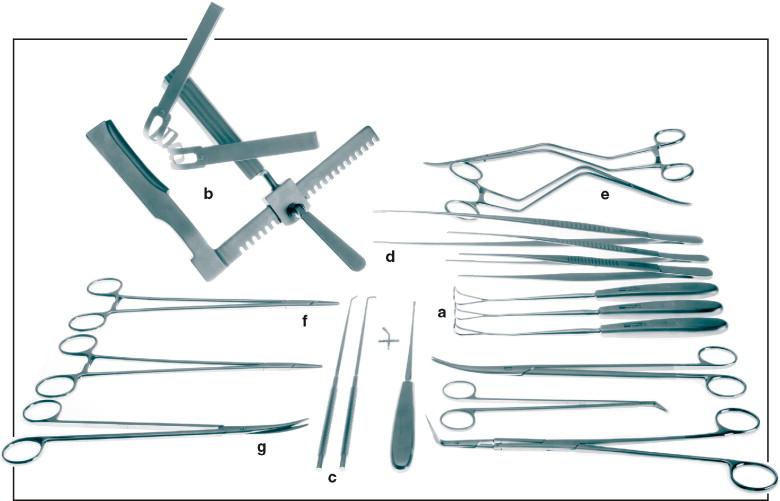
Median sternotomy is the preferred approach in patients undergoing valve surgery as well as in the reoperative setting ( Fig. 4-2 ). In this era of less invasive surgery, the 20-cm skin incision, commonly used in the past, is no longer necessary (inset) . A smaller, 8- to 10-cm skin incision is cosmetic and less traumatic, and yet provides adequate exposure to perform a full sternotomy with optimal opening. Special attention should be given to dissection of substernal tissues in order to avoid opening pleural spaces.
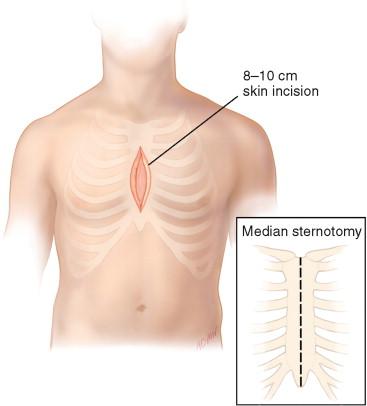
Proper positioning of the sternal retractor is obtained by ensuring that the midpoint between the two central anchoring mechanisms is aligned with the right atrial appendage ( Fig. 4-3 ).
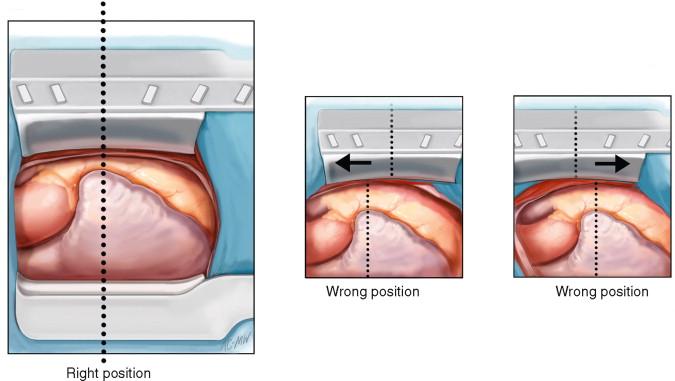
This approach is used in mitral valve surgery for cosmetic reasons or in redo operations ( Fig. 4-4 ). It is contraindicated in patients with previous right-sided chest surgery, moderate to severe aortic regurgitation, or severe chronic obstructive pulmonary disease. The patient is rotated 30 degrees to the left side. A 12- to 15-cm right anterolateral thoracotomy is performed through the fourth intercostal space. A double-lumen endotracheal tube is used to decompress the right lung. Before the patient is draped, an external defibrillator is placed for subsequent defibrillation. The opening of the thorax is limited to the minimal amount required for atrial or superior vena cava cannula- tion. Cannulation of the ascending aorta is possible in most patients.
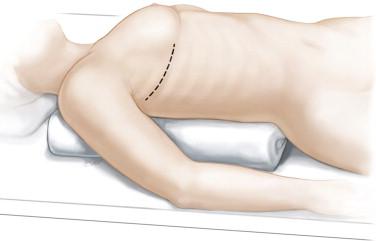
Less invasive surgery is attractive because of numerous claimed advantages: better cosmetics, less bleeding, decreased risk of infection, reduced pain, shorter hospital stay. Certain risks have been emphasized, however, such as a higher incidence of stroke. Actually, the main potential disadvantage of less invasive mitral valve surgery is the execution of a suboptimal operation as a result of suboptimal exposure (e.g., a valve replacement instead of a valve repair, a palliative repair technique instead of a reconstructive valve operation). Excellent exposure is a requisite in surgery, in particular in reconstructive valve surgery. The incision may be large or small; the important point is that it provides a good visualization of the different structures of the valve regardless of their depth. Some surgeons with extensive experience in reconstructive surgery have been able to meet this challenge using different less invasive approaches.
Less invasive surgery is attractive for the patient but more demanding for the surgeon. The potential drawback is the execution of a suboptimal operation.
Ministernotomy may be used both for aortic and for mitral or tricuspid valve surgery. Two alternatives may be used: The upper ministernotomy ( Fig. 4-5 ) extends from the sternal notch to the third or fourth right intercostal space; it is particularly indicated for aortic valve surgery. The lower ministernotomy ( Fig. 4-6 ) extends from the xyphoid process to the second right intercostal space; it is indicated for mitral and tricuspid valve surgery. Access to the mitral valve is achieved through the interatrial groove or the atrial septum. Cannulation of the ascending aorta is possible, particularly when using the upper ministernotomy. Peripheral arterial cannulation is advisable if access to the ascending aorta is limited or aortic calcifications are present. Venous cannulation is performed either percutaneously, using the right femoral vein and the jugular vein, or directly through the right atrium. Assisted vacuum is essential to facilitate venous drainage.
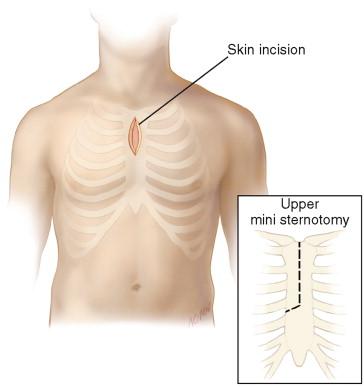
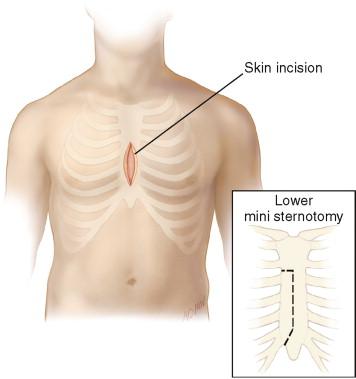
Become a Clinical Tree membership for Full access and enjoy Unlimited articles
If you are a member. Log in here